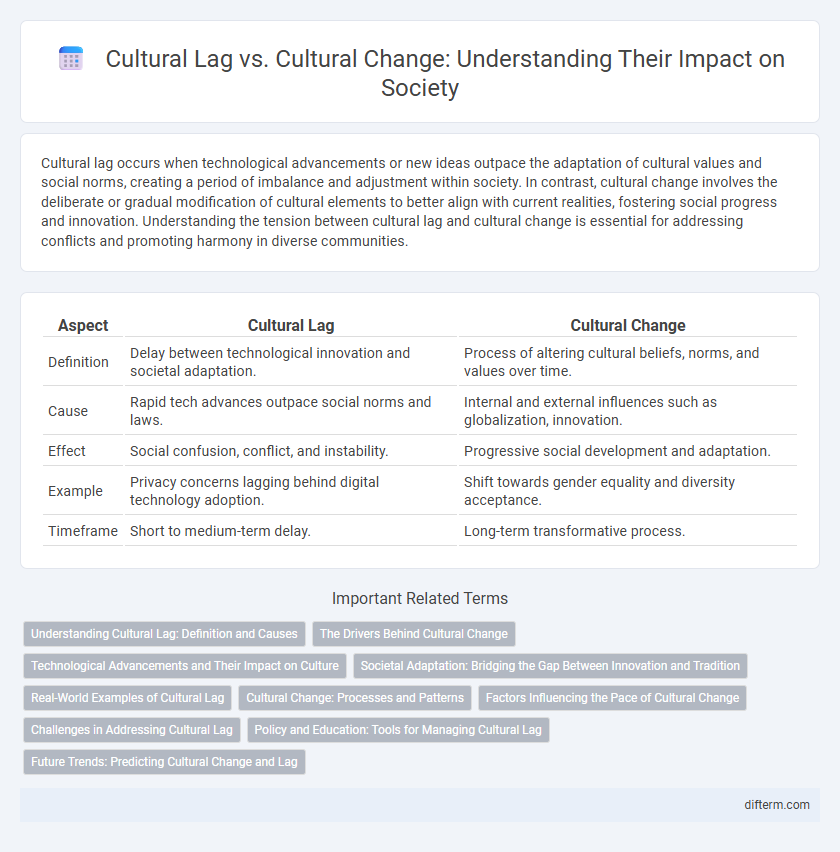Cultural lag occurs when technological advancements or new ideas outpace the adaptation of cultural values and social norms, creating a period of imbalance and adjustment within society. In contrast, cultural change involves the deliberate or gradual modification of cultural elements to better align with current realities, fostering social progress and innovation. Understanding the tension between cultural lag and cultural change is essential for addressing conflicts and promoting harmony in diverse communities.
Table of Comparison
| Aspect | Cultural Lag | Cultural Change |
|---|---|---|
| Definition | Delay between technological innovation and societal adaptation. | Process of altering cultural beliefs, norms, and values over time. |
| Cause | Rapid tech advances outpace social norms and laws. | Internal and external influences such as globalization, innovation. |
| Effect | Social confusion, conflict, and instability. | Progressive social development and adaptation. |
| Example | Privacy concerns lagging behind digital technology adoption. | Shift towards gender equality and diversity acceptance. |
| Timeframe | Short to medium-term delay. | Long-term transformative process. |
Understanding Cultural Lag: Definition and Causes
Cultural lag occurs when non-material culture, such as beliefs and values, fails to keep pace with rapid changes in material culture like technology, creating social conflicts and inefficiencies. Causes include technological advancements outstripping societal norms, institutional resistance to change, and communication gaps between generations. Understanding these factors helps explain the delays in societal adaptation and the resulting cultural tensions.
The Drivers Behind Cultural Change
Technological advancements act as primary drivers behind cultural change, accelerating shifts in societal norms and values while often creating a gap known as cultural lag. Economic development and globalization also significantly influence cultural evolution by introducing new ideas, practices, and communication methods that challenge traditional customs. Social movements and demographic changes further propel cultural transformation, reshaping collective behaviors and fostering adaptive responses within communities.
Technological Advancements and Their Impact on Culture
Technological advancements often drive cultural change by introducing new tools and communication methods that reshape social behaviors and values. Cultural lag occurs when societal norms, laws, and institutions struggle to adapt quickly to these innovations, creating a gap between technology and cultural acceptance. This delay can lead to social tensions and conflicts as communities attempt to reconcile traditional practices with emerging technological realities.
Societal Adaptation: Bridging the Gap Between Innovation and Tradition
Societal adaptation navigates the tension between cultural lag and cultural change by aligning innovative advancements with established traditions. Cultural lag occurs when non-material culture struggles to keep pace with material innovations, creating a temporal gap that challenges social norms and institutions. Bridging this gap requires proactive mechanisms such as education, policy reform, and inclusive dialogue to harmonize evolving technologies with enduring cultural values.
Real-World Examples of Cultural Lag
Cultural lag occurs when technological advancements outpace societal norms, such as the widespread use of smartphones leading to delayed privacy legislation in many countries. In real-world examples, ride-sharing platforms disrupted traditional taxi industries, creating legal and ethical challenges that governments struggled to regulate promptly. These cases highlight how cultural change often trails behind innovations, resulting in social tensions and regulatory gaps.
Cultural Change: Processes and Patterns
Cultural change occurs through processes such as innovation, diffusion, and social movements, which alter existing norms and values over time. Patterns of cultural change often follow stages of resistance, adaptation, and eventual integration into society, reflecting shifts in technology, economy, and social structures. Understanding these dynamics is essential for analyzing how cultures evolve and respond to internal and external pressures.
Factors Influencing the Pace of Cultural Change
Factors influencing the pace of cultural change include technological advancements, social values, and economic conditions, which can accelerate or hinder adaptation within societies. Cultural lag occurs when non-material culture, such as beliefs and norms, fails to keep pace with material culture innovations, creating a temporal gap in societal evolution. The interplay between innovation diffusion and resistance to change shapes how quickly cultural practices and institutions transform over time.
Challenges in Addressing Cultural Lag
Addressing cultural lag poses significant challenges due to the asynchronous pace at which material culture, such as technology, evolves compared to non-material culture, including norms and values. This lag creates social tensions and resistance, making it difficult for institutions to adapt policies that align with new technological realities. Efforts to bridge cultural lag require comprehensive education, policy reform, and cross-disciplinary collaboration to foster societal acceptance and integration of innovation.
Policy and Education: Tools for Managing Cultural Lag
Policy and education serve as critical tools for managing cultural lag by accelerating the integration of new technologies and social norms into societal frameworks. Educational programs promote awareness and adaptability, while policy reforms establish regulations that align technological advancements with ethical and social standards. Together, these mechanisms reduce the delay in cultural adjustment, fostering a more harmonious interaction between tradition and innovation.
Future Trends: Predicting Cultural Change and Lag
Future cultural change will likely accelerate due to rapid technological advancements in AI, biotechnology, and communication platforms, outpacing societal norms and regulations and creating cultural lag. Predictive analytics and big data allow sociologists to identify emerging value shifts and anticipate conflicts that arise from this lag in adapting legal and ethical frameworks. Understanding these dynamics will be essential for policymakers and cultural institutions to manage cultural evolution and mitigate social friction in an increasingly digital and globalized world.
Cultural lag vs Cultural change Infographic

 difterm.com
difterm.com